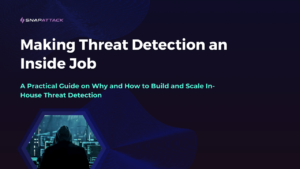Why Proactive Threat Hunting?
When the average data breach costs organizations over $4 million, a proactive cybersecurity posture isn’t just nice to have – it’s essential. But traditional cybersecurity frameworks tend to be reactive in nature, remediating attacks that have already occurred rather than identifying potential risks that may impact the organization down the road.
Solutions like firewalls, anti-virus software, and intrusion detection systems effectively provide a basic level of protection against cyber attacks. However, these alone are simply not enough – in today’s cyber landscape, breaches are no longer an “if” but a “when”. That’s where threat hunting comes in.
What is Threat Hunting?
Threat hunting is an approach to identifying and neutralizing cyber threats by actively searching for threats that have evaded detection by other security measures. Unlike reactive security measures, which are more like network guardrails, threat hunting enables organizations to detect threats that have already infiltrated their systems, find new and emerging threats, and neutralize them before they cause significant damage.
While threat hunting is an advanced activity that can be highly effective, it has its fair share of challenges. It’s generally narrow in its scope and it’s limited to the data that teams already have and the detection rules they’ve already determined. Additionally, a typical threat hunting approach is reactive in nature because threat hunters seek to identify threats that are already present in a network.
For threat hunting to reach its full potential as a preventative security measure, its capabilities must be expanded from what teams already know to include everything that they don’t.
Proactive threat hunting will be essential for security teams in 2023. Check out security experts’ predictions for 2023 trends in threat hunting here.
Reactive Threat Hunting vs. Proactive Threat Hunting
A typical threat hunt is centered around known threats – but proactive threat hunting takes a step back and asks the question, “What about the threats we don’t know about?”
Though proactive threat hunting is a more complex, difficult framework than its traditional counterpart, it’s also immensely rewarding. It places an emphasis on continuous improvement and a deep understanding of one’s own environment and vulnerabilities within an organization.
| Reactive threat hunting | Proactive threat hunting |
| Starts with a known threat | Starts with unknown threats
What don’t we know about? |
| Scope of the hunt examines only what you already know | Scope of the hunt searches for the threats you haven’t found yet
What’s lurking in our network? |
| Studies threat intelligence for expected, upcoming, or ongoing threats | Studies threat intelligence to determine the threats you might face in the future + how you might go about detecting them
What do we need to look out for? How will we know when we find it? |
| Retraces past steps of threat actors to see where they’ve been | Equips behavioral detections and TTPs to get ahead of threat actors’ future actions
Where are they going and how will they get there? |
| The hunt ends when the present threat is no longer in the network | The hunt never ends – it’s ongoing to remediate past attacks, close current visibility + measurement gaps, and prevent future attacks from occurring
What else do we need to look for? How does that change with time? How can we get ahead? |
Discover emerging threat hunting frameworks and learn how to take a proactive threat hunting stance from our webinar replay, “The Art + Science of Pre-Crime Threat Hunting”.
The Challenges to Proactive Threat Hunting at Scale
As valuable as it may be, there’s a reason proactive threat hunting isn’t the industry standard – it comes with its fair share of challenges.
Challenge to Proactive Threat Hunting #1: Prioritization is Crucial
Knowing which threats are truly relevant to threat hunters and their environment is possibly the greatest challenge of all. It’s not about preparing for every single threat that could possibly infiltrate your systems – just the ones that have actual potential to cause damage (which is still an enormous volume). This is why threat hunting can be so difficult to act on – in a sea of endless threats that only continues to grow, it’s extremely challenging to know which ones to prioritize.
Challenge to Proactive Threat Hunting #2: Searching for the Unknown
Reactive threat hunting follows what is already known about a network’s vulnerabilities and existing threats…but this isn’t the case with proactive threat hunting. Proactive threat hunting is, by definition, all about getting ahead of what hasn’t yet occurred. The pool of existing threats is finite and straightforward compared to the vast array of unknown threats. Even once threat hunters have narrowed down what is most relevant to them, the work is nowhere near done.
Challenge to Proactive Threat Hunting #3: Resource Gap
In cybersecurity, the skill gap is widening by the minute. Threat hunting is especially affected: very few professionals across the world actually hold the title of “threat hunter”, and among them, skill levels are varied. As a result, staff with other roles, such as SOC and IR analysts, are assigned to the role of threat hunter – stretching already strained teams even thinner.
Because threat hunting teams are often smaller than other teams in a security department, senior leadership fails to allocate adequate resources and budget to threat hunters. This feeds further into the endless loop of under-resourced, overworked threat hunting teams.
Challenge to Proactive Threat Hunting #4: Reactive by Design
Many threat hunting tools on the market and the frameworks hunters follow are reactive by design, focused on incident response over investigation. Turning a threat hunt from a fire drill into a preventative search requires tools and methodologies that look for what’s lurking in the great unknown rather than identifying what’s already in the network.
SnapAttack utilizes machine learning and data science to enhance threat detection. Find out how you can do the same here.
Why Proactive Threat Hunting is Important: Benefits to Proactive Threat Hunting
Though there are barriers to proactive threat hunting, its value can’t be overstated. Proactive threat hunting positions organizations to get ahead of the threat with a comprehensive knowledge of their looming vulnerabilities.
Proactive Threat Hunting Benefit #1: Improved Response Time
When cyber threat hunters seek out threat actors that have yet to intrude rather than chase down those that have already entered their network, they’re able to break the kill chain earlier and reduce the time taken to respond to events. This shaves time off both the hunt itself and the remediation period that would typically follow a cyber incident.
Proactive Threat Hunting Benefit #2: Streamlined Investigation
Proactive threat hunting provides security teams with valuable insights into their security posture and the space to truly leverage those insights, allowing teams to zoom out and see the bigger picture of how they stack up against emergent threats.
Proactive Threat Hunting Benefit #3: Greater Visibility
Reactive threat hunting can feel like a game of cat-and-mouse in which threat hunters are reactively chasing down threats as they’re identified. On the other hand, by consistently monitoring their environment to identify vulnerabilities and emerging threats, proactive threat hunters gain and maintain a more thorough understanding of their environment.
SnapAttack cuts the time it takes to complete a threat hunt down by 87%. Learn about our solutions for threat hunters.
Proactive Threat Hunting as a Process
To leverage the benefits of a proactive threat hunting program, organizations should align behind a united, repeatable process. The threat hunting process can be broken down into several stages:
- Set the stage for proactive threat hunting at scale
- Collect and analyze data
- Build the hunt hypothesis
- Investigate threats
- Respond and mitigate
Proactive Threat Hunting Step #1: Set the Stage for Proactive Threat Hunting at Scale
Assigning clear roles, responsibilities, and a scope for hunting ahead of time helps teams develop a streamlined, repeatable, and concise process. Additionally, setting expectations for each individual role helps to establish a set hierarchy and workflow with defined roles for each team member.
Regardless of all other organization-specific factors, to achieve a proactive approach, context is key. Understanding how one’s unique environment fits in with the surrounding threat landscape helps hunters prioritize based on what’s truly relevant to them.
Proactive Threat Hunting Step #2: Collect and Analyze Data
Threat hunters begin the hunt by collecting and analyzing network data from multiple sources, including:
- Logs
- Network traffic
- Endpoint data
- Threat intelligence
- Alerts
- Dark web monitoring
- Manual hunting
- XDR
Threat hunters look to these sources to identify Indicators of Attack (IOAs), Indicators of Compromise (IOCs), and tactics, techniques, and procedures (TTPs). In a proactive threat hunting framework, data must be analyzed in real-time to prevent damage from incoming threats.
Many organizations accomplish this through advanced analytics that utilize machine learning and artificial intelligence. Additionally, manually searching for relevant threat intelligence is a key differentiator to take a threat hunting program from reactive to proactive, taking hunters out of their immediate environment and opening their eyes to what else lies on the outside.
SnapAttack’s world-class threat intelligence library is constantly growing with new intelligence added within 24 hours. Learn more about the SnapAttack platform here.
Proactive Threat Hunting Step #3: Build the Hunt Hypothesis
Threat hunters then move on to leverage the data they’ve collected and analyzed across sources to craft a clear and actionable hunt hypothesis. Like a scientific hypothesis, a hunt hypothesis must be testable and relevant to the threat at hand. Some steps to take in the development of a hunt hypotheses are:
- Determine the hunt approach – threat actor focused, vulnerability focused, specific technique focused
- Determine threats that are relevant to the organization
- Determine threat actors that target the organization’s industry or region
- Understand TTPs leveraged by the threat
- Understand the set of data available to the hunter including the window of time that dataset covers and the likelihood of success in discovering malicious activity within the dataset available
Upon working through the above analysis, you’re armed with the information needed to build a hunt hypothesis. Some examples of a hunt hypothesis are:
- Our intelligence sources indicate APT29 is an adversary that poses a risk to my organization. Research indicates APT29 has successfully leveraged phishing attacks to gain initial access and deliver a Cobalt Strike payload to targets. We believe we can discover if this technique has been used against our organization by searching for execution of suspicious powershell usage within our endpoint telemetry stored in our SIEM and/or EDR.
- Our intelligence sources indicate that various adversaries evade detection by disabling endpoint protection and anti-virus products. We believe we can discover usage of this technique by searching for malicious Stop-Service commands in our EDR telemetry.
- Our intelligence sources indicate adversaries have successfully leveraged exploitation of a new Windows zero-day vulnerability to gain initial access to victim organizations. Analysis indicates we are exposed to this vulnerability. We believe we can hunt 12 months of historical artifacts in our SIEM for exploitation.
After building a comprehensive and testable hypothesis, threat hunting teams can begin the investigation.
Proactive Threat Hunting Step #4: Investigate Threats
To prove or disprove the hunt hypothesis, threat hunters begin diving into any anomalies they previously identified in the network. Threat hunters use advanced tools such as SIEM, EDR, NDR, and XDR to reach a conclusive result. The investigation period continues until the hunt hypothesis is confirmed to be true or false – and if the threat is determined to be present, time is of the essence in crafting a response.
Proactive Threat Hunting Step #5: Respond to and Mitigate Threats
Based on the results of the investigation, threat hunting teams must develop and implement a response plan to neutralize the threat. This step obviously depends heavily on the nature of the threat, but in a proactive threat hunting model, it’s also never truly over.
Whether a threat is actively damaging the network or it’s momentarily benign, documenting and addressing every relevant threat builds a more comprehensive and clear perspective of an organization’s security landscape.
Threats are constantly evolving, and just because a response plan is sufficient in one moment, that doesn’t mean it still will be a year or even a month from the time of its launch. Consistent monitoring and improvement of the implemented plan is crucial for organizations to stay proactive and prevent incoming threats.
From this point forward, eliminating existing vulnerabilities and taking further actions to improve future security standing helps organizations stay ahead of incoming threats. Any trends that threat hunting teams observe in their environment can inform future threat hunts and improve existing controls as well.
Leverage threat-informed defense as you develop a proactive threat hunting program. Learn how from our webinar replay, “Demystifying the Tradecraft of Threat-Informed Defense”.
Conclusion: Proactive Threat Hunting is Essential
Though proactive threat hunting was once a competitive edge for modern security teams, it’s quickly becoming a necessity. Proactive threat hunting is a must for organizations with complex environments and advanced threats – and with today’s highly motivated and evasive threat actors, absolutely anyone could be vulnerable.
Knowing yourself and your environment is the beginning and end of a successful threat hunting program. A comprehensive, constantly monitored, and consistently updated threat hunting program can aid organizations in enhancing their perspective of not just their threat landscape but their own security posture. And when it’s maintained properly, a proactive threat hunting program can scale across expansive environments and only grows stronger with time.
SnapAttack was built by threat hunters, CISOs, and SOC leaders, and threat hunters for threat hunters, CISOs, and SOC leaders.
By rolling intel, adversary emulation, detection engineering, threat hunting, and purple teaming into a single, easy-to-use product with a no-code interface, SnapAttack enables you to get more from your technologies, more from your teams, and makes staying ahead of the threat not only possible but also achievable.
Schedule a demo today to see how you can finally answer the question, “Are we protected?” with confidence.




